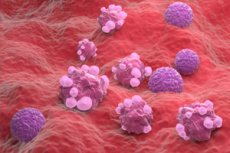New publications
Artificial intelligence predicts response to cancer therapy based on data from each tumor cell
Last reviewed: 02.07.2025

All iLive content is medically reviewed or fact checked to ensure as much factual accuracy as possible.
We have strict sourcing guidelines and only link to reputable media sites, academic research institutions and, whenever possible, medically peer reviewed studies. Note that the numbers in parentheses ([1], [2], etc.) are clickable links to these studies.
If you feel that any of our content is inaccurate, out-of-date, or otherwise questionable, please select it and press Ctrl + Enter.

With over 200 types of cancer and each case being unique, ongoing efforts to develop precision cancer treatments remain challenging. The focus is on developing genetic tests to identify mutations in cancer driver genes and tailoring treatments to target these mutations.
However, many, if not most, cancer patients do not significantly benefit from these early targeted therapies. In a new study published in Nature Cancer, first author Sanju Sinha, PhD, an assistant professor in the Molecular Cancer Therapy Program at Sanford Burnham Prebys, along with lead authors Eitan Ruppin, MD, PhD, and Alejandro Schaffer, PhD, of the National Cancer Institute, part of the National Institutes of Health (NIH), and colleagues describe a unique computational system for systematically predicting how patients will respond to cancer drugs at the single-cell level.
Called PERSONALIZED ONCOLOGY TREATMENT PLANNING BASED ON SINGLE-CELL TRANCIPLE EXPRESSION (PERCEPTION), the new AI-powered approach delves into transcriptomics—the study of transcription factors, mRNA molecules that are expressed by genes and translate DNA information into action.
"Tumors are complex and constantly changing organisms. Using single-cell resolution allows us to address both of these challenges," says Sinha. "PERCEPTION enables us to use the rich information from single-cell omexics to understand the clonal architecture of a tumor and monitor the emergence of resistance." (In biology, omexics refers to the sum of the parts within a cell.)
Sinha says: "The ability to monitor the emergence of resistance is the most exciting part for me. It has the potential to allow us to adapt to the evolution of cancer cells and even change our treatment strategy."
Sinha and colleagues used transfer learning, a branch of AI, to create PERCEPTION.
"Limited single-cell data from clinics was our main challenge. AI models need large amounts of data to understand disease, just as ChatGPT needs huge amounts of text data from the internet," explains Sinha.
PERCEPTION uses published bulk gene expression data from tumors to pre-train its models. Then, single-cell level data from cell lines and patients, although limited, was used to tune the models.
PERCEPTION has been successfully validated in predicting response to monotherapy and combination therapy in three independent, recently published clinical trials in multiple myeloma, breast cancer, and lung cancer. In each case, PERCEPTION correctly stratified patients into responders and non-responders. In lung cancer, it even captured the development of drug resistance as the disease progressed, a significant finding with great potential.
Sinha says PERCEPTION is not yet ready for use in the clinic, but the approach shows that information at the level of individual cells can be used to guide treatment. He hopes to encourage the adoption of the technology in clinics to generate more data that can be used to further develop and improve the technology for clinical use.
"The quality of prediction improves with the quality and quantity of data on which it is based," Sinha says. "Our goal is to create a clinical tool that can systematically and data-drivenly predict treatment response in individual cancer patients. We hope that these findings will stimulate more data and similar studies in the near future."
